(Post 1 of 3 in this blog series)
Gardeners, especially those new to gardening may find they have a “black thumb.” Plants die for no reason! “Oh well chuck it in the greenwaste recycling can and start again.” Or… “Oh I can’t grow cyclamens!… They always die in my garden for some reason.” For many gardeners it is mysterious why some plants fail to thrive or die suddenly. Plant disease processes are complicated, and it requires some knowledge of botany (anatomy and physiology), genetics, and microbiology to really understand what is happening. Also, since microbes are microscopic and most pathogens are microbial we can’t always see them at work, especially before symptoms develop. Symptoms are plant responses to the action of a disease agent. In this post I will try to describe the different kinds of diseases, and where they come from.
There are two broad categories …
of plant disease possible in gardens: biotic diseases and abiotic diseases. Biotic diseases have a disease agent called a pathogen. The pathogen can be microbial, or a nematode or a virus, or a parasitic seed plant. Bacteria and fungi are the most common microbes. It is debatable whether viral particles are living, so also debatable whether or not they are considered microbes. Of the biotic pathogens, fungi cause most diseases in gardens. Many pathogens rely on environmental conditions to favor their lifestyle, this is particularly true of bacteria which like moist, warm environments.
The other category of disease is the abiotic category. Abiotic diseases have no pathogen. An environmental condition such as an excess or lack of an environmental condition causes physiological changes in plants that develop symptoms. Extremes of temperature, light, humidity, soil or water chemistry, soil physical conditions, air quality, and pesticide residue can all lead to abiotic diseases. Since there is no pathogen there is no epidemic, and abiotic diseases are not infectious. So spread, occurrence and movement of abiotic diseases are usually different than biotic disorders
So how does disease happen?
I have heard many gardeners make sweeping statements like “overwatering killed my plant” or “It just died of neglect” or “insects killed it”. Plant pathologists describe the disease process with a cartoon called the disease tetrahedron. It describes the interaction of four things: the pathogen, the environment, the host and time. Of course it is only a triangle for abiotic diseases since there is no pathogen.
For disease to occur there must be an active pathogen present that is virulent (has genes to cause disease). The pathogen must have enough inoculum present to begin the disease process. A single spore rarely leads to a successful disease (although it can in some systems). Most importantly the pathogen must have the right genetics to recognize its host.
Next the environment must be conducive to the pathogen and its development and/or harmful or stressful to the host. The environment can cause the host stress while favoring the pathogen. An example would be oxygen starvation in flooded roots. The environment must favor the pathogen’s build up and dispersal of its inoculum (infective propagules such as spores, cells or seeds). Often splashing rain during the warming spring period is important for their spores to reach a susceptible host.
Finally for disease to happen, the host must be susceptible to the pathogen and possibly predisposed in some way to its attack. Pathogens also have phenotypic synchronicity, that is the ability to produce inoculum at the same time as the host is producing susceptible plant tissues (leaves, buds or stems).
The final facet of the tetrahedron is time. Diseases do not occur instantaneously (even though we may only notice them instantly) – it takes time for them to develop. Disease life cycles or life histories describe how pathogens survive, reproduce and disseminate themselves through the environment over time. The tetrahedron can be used to understand the factors that lead to disease but also can be used as a way to stop or control diseases (more on that in another post).
So where do diseases come from and where are they going?
Abiotic diseases are caused by environmental extremes. Another way to look at them is that they occur when there is a violation of the adaptations of the host. In this regard when we grow plants not well adapted to our climate or environment they can be harmed. A good example is my papaya tree. Right now it has been harmed by low temperatures. Growing a papaya in Ojai, CA is a violation of its adaptations.
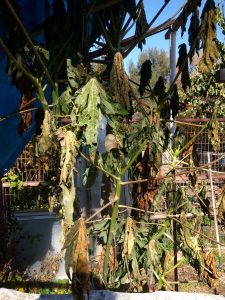
If abiotic factors don’t cause actual symptoms, sometimes they are able to weaken the host so that a pathogen can enter, and begin disease formation. So abiotic conditions are often predisposing factors for the development of biotic pathogens. Many of the root rot pathogens such as Phytophthora or Armillaria
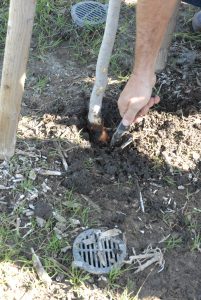
require a predisposing abiotic factor such as drought, saturated soils, high salinity or compaction to facilitate disease development.
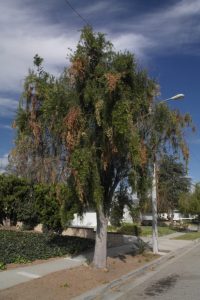
So where do pathogens come from?
I like the hospital analogy. Where do you go to get sick? A hospital! They certainly have a difficult time controlling the spread of disease there because that is where sick people go. So where do sick plants come from? Often a nursery! Nurseries import plants from wholesale sources, propagate from their own stock, sometimes reuse their container media, and grow many hosts in a concentrated place over time. There is no better place for diseases to occur than in nurseries.
This is especially true of root diseases because roots are inside the container and often not observed at the time of purchase
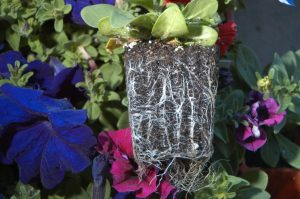
(but you always should inspect roots of all purchased plants from six packs of garden flowers to boxed trees). Also, some nurseries suppress diseases with fungicides that do not eradicate the pathogen, so when fungicides wear off (after you purchase your plant), disease can develop from now unsuppressed pathogens. Nurserymen relax! I’m not saying that all nurseries sell diseased plants (at least knowingly), but consumers should take extra care when selecting plants and when bringing new plants to their property.
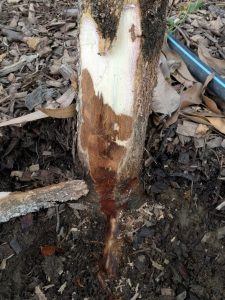
Once pathogens establish in the landscape, they may continue to harm new plants. Some pathogenic spores blow in on wind or inoculum moves in water courses along streams or other water paths. Animals, people and equipment can move infested soil onto a property. Once diseases have run their course, pathogens often survive as saprophytes in the diseased tissues. They overwinter or over-summer in debris on the ground. So sanitation is critical in disease control (more on this in another post). Fruiting bodies can be moved in the greenwaste stream but there is very little research showing that disease is initiated by contaminated greenwaste, even though some pathogens may survive there. We do know that when greenwaste is chipped, it dramatically reduces pathogen and insect survival. Stockpiling wastes for as little as seven days will reduce chances pathogen survival by an order of magnitude. Certainly our favored arborist chips are very unlikely to have viable pathogens especially when sourced locally.
Understanding that diseases are not usually caused by gardening practices but by a pathogen or an environmental factor is the first step in diagnosis and control. In my next post I will talk about disease diagnosis and detection…
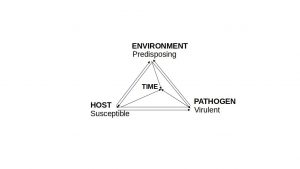
Do you mean that we should pull the plant out of its pot or six little plants out of their containers and check the roots? If so (or whatever you mean), what do we look for? Thanks.
Hi Mary. Yes I always pull at least one to check root condition. If the tops are uniform so usually will be the roots. The trouble is that sometimes tops can look ok,not wilted, even in bloom, and the roots will be completely rotten. You will soon learn what bad roots look like, brown no white…
What a tour de force! Of real value to the serious gardener. We used to call your triangular relationship as a syndrome in lectures to our horticultural students. Good to read about it again and to hear ‘predisposition’ discussed
Roger, you are welcome. I will go deeper into detecting diseases and finally controlling them in the garden in the next two blogs…